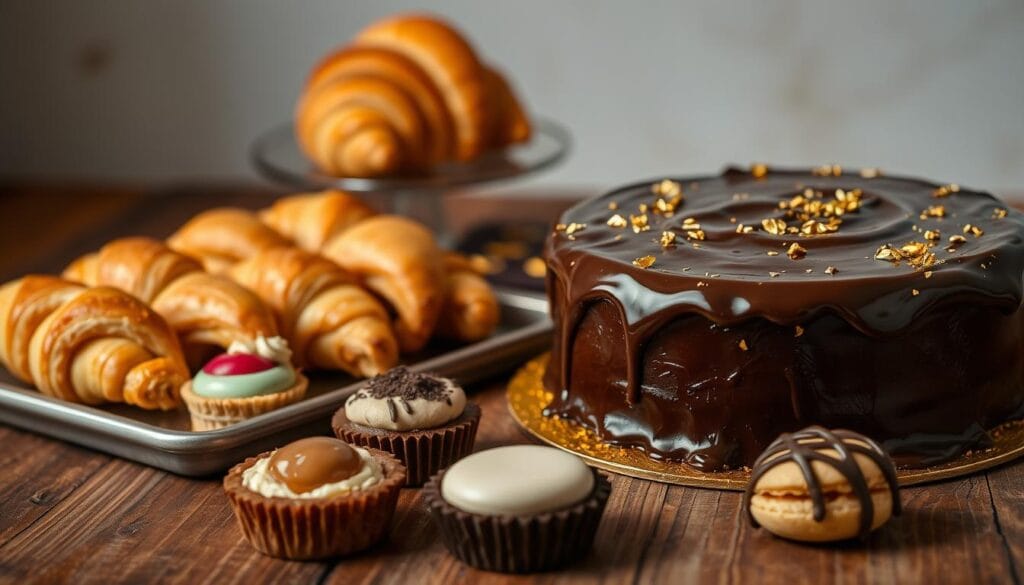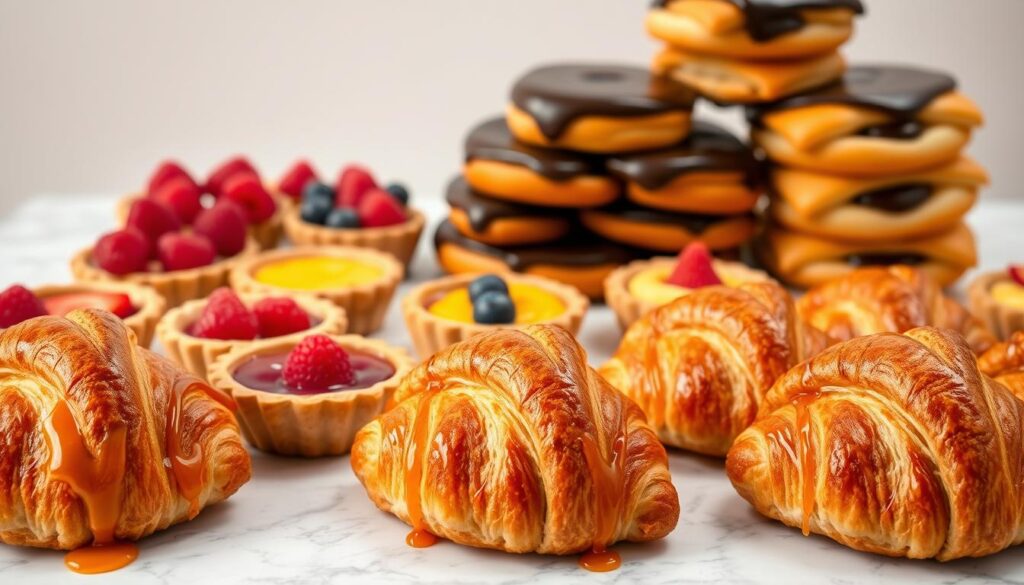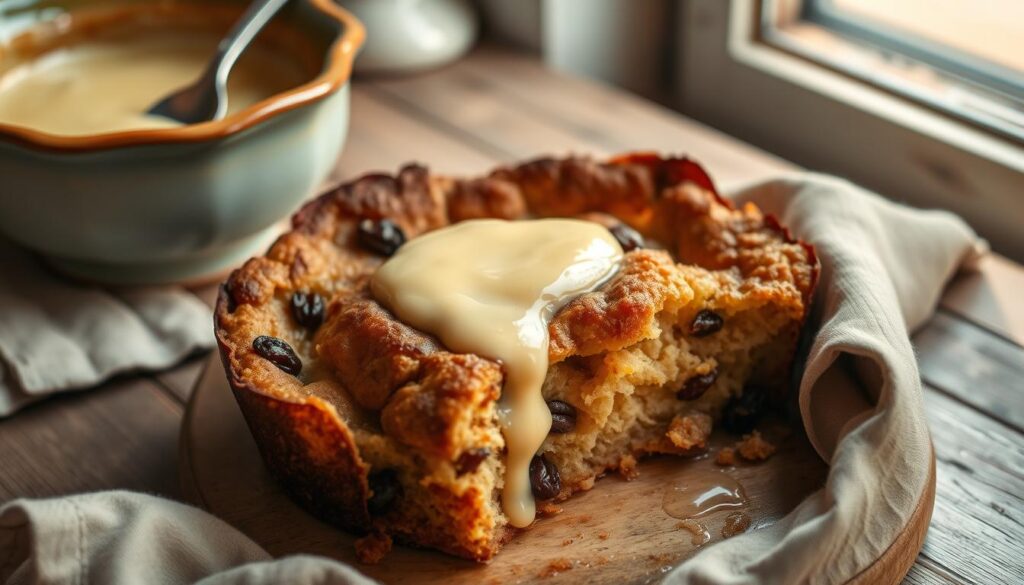HowToCook.news – Your Ultimate Guide to Delicious Cooking!
Baked Desserts: Satisfy Your Sweet Tooth
Baked Desserts: Satisfy Your Sweet Tooth
Table of Contents
Baked Desserts: Satisfy Your Sweet Tooth

Baked desserts are the ultimate comfort food, bringing joy to millions. They range from warm chocolate chip cookies to elegant French pastries. These treats offer something special for every taste.
The art of baking turns simple ingredients into delicious creations. These creations tantalize our taste buds and create lasting memories.
Pastries are more than just food; they’re a culinary experience. They connect people through shared traditions and flavors. Whether you’re new to baking or experienced, baked desserts offer endless possibilities for creativity and deliciousness.
Exploring baked desserts reveals a rich world of textures, flavors, and techniques. Both home bakers and professional pastry chefs know the magic of combining precise ingredients with perfect baking methods.
Key Takeaways
- Baked desserts offer diverse flavor experiences
- Pastries connect people through culinary traditions
- Baking combines science and creativity
- Home baking can be both fun and rewarding
- Different techniques create unique dessert textures
Understanding the Art of Baked Desserts
Diving into baked desserts needs passion, precision, and knowing the basics. Whether making muffins or pastries, learning the fundamentals can make your baking better.
Baking is both a science and an art. To succeed, you must grasp key principles for tasty results every time.
Essential Baking Equipment and Tools
Professional bakers know quality tools are key for great baked desserts. The right tools can take your baking from good to amazing.
- Precision measuring cups and spoons
- Stand mixer or hand mixer
- Baking sheets and pans
- Cooling racks
- Silicone spatulas
- Pastry brush
Basic Ingredients for Success
Knowing what each ingredient does is vital for perfect muffins and treats. Each ingredient adds to the texture and flavor.
| Ingredient | Function | Best Practice |
|---|---|---|
| Flour | Structure | Sift for smoother texture |
| Sugar | Sweetness and browning | Measure precisely |
| Eggs | Binding and moisture | Use room temperature |
| Butter | Flavor and richness | Cream until light |
Temperature and Timing Fundamentals
Getting the temperature right is what sets pros apart from amateurs. Consistent heat leads to even baking and perfect results.
- Preheat oven 15-20 minutes before baking
- Use an oven thermometer for accuracy
- Check baked goods 5 minutes before recommended time
- Allow proper cooling on wire racks
Learning these basics will help you bake desserts with confidence and skill.
Classic Cake Varieties and Techniques
Cakes are a delightful art form that mixes science and creativity. Knowing about different cakes helps home bakers make treats that wow everyone.
Cakes come in many styles, each with its own traits and ways to make them. Professional bakers know the basics of cake types. These basics are key to making tasty baked desserts.
- Layer Cakes: Multi-tiered creations perfect for celebrations
- Sheet Cakes: Ideal for large gatherings and casual events
- Bundt Cakes: Distinctive ring-shaped cakes with elegant designs
- Pound Cakes: Dense, rich cakes with classic butter flavor
Getting good at cake making takes skill and practice. Important skills include:
- Proper ingredient measurement
- Creaming butter and sugar correctly
- Gentle ingredient folding
- Maintaining consistent mixing temperatures
| Cake Type | Texture | Best Use |
|---|---|---|
| Sponge Cake | Light, airy | Layered desserts, roll cakes |
| Chiffon Cake | Soft, delicate | Elegant occasions |
| Chocolate Cake | Rich, dense | Birthday celebrations |
Bakers can make their cakes even better by trying new flavor combinations and decorating ideas. Whether you’re new or experienced, learning about these basic cake types can lead to endless tasty adventures.
Irresistible Homemade Cookie Recipes
Cookies are the ultimate comfort baked desserts that bring joy to kitchens across America. Whether you’re a novice baker or a seasoned pro, mastering the art of cookies can transform your home baking experience. From classic chocolate chip to innovative flavor combinations, these sweet treats offer endless possibilities for creativity and deliciousness.
Soft vs. Crispy Cookie Textures
The texture of cookies depends on several key factors. Soft cookies typically require ingredients like brown sugar and butter, which create a tender, chewy experience. Crispy cookies, by contrast, benefit from granulated sugar and longer baking times.
- Soft Cookies: Use more moisture, lower baking temperature
- Crispy Cookies: Less moisture, higher baking temperature
- Ingredient ratios dramatically impact final texture
Popular Cookie Flavor Combinations
Exploring unique flavor profiles can elevate your baked desserts from ordinary to extraordinary. Classic combinations remain beloved, while innovative approaches continue to surprise and delight.
| Classic Flavor | Unique Twist |
|---|---|
| Chocolate Chip | Sea Salt Caramel Chocolate Chip |
| Oatmeal Raisin | Maple Pecan Oatmeal |
| Sugar Cookie | Lavender Lemon Sugar Cookie |
Storage and Freshness Tips
Proper storage is crucial for maintaining the delectable quality of homemade cookies. Air-tight containers, strategic layering, and smart ingredient selection can help preserve that fresh-baked taste.
- Use sealed containers with parchment between layers
- Store different cookie types separately
- Freeze cookies for extended freshness
“The secret to great cookies is love, precision, and a dash of creativity.” – Professional Baker
Perfect Pies and Flaky Crusts
Making the perfect pie is an art that needs precision, creativity, and passion. Pies are more than desserts; they’re a canvas for seasonal ingredients and baking skills. The key to amazing pies is mastering the crust and filling.
To make a flaky pie crust, you need to pay close attention and use the right techniques. Cold ingredients are key for that light and crispy texture. Bakers say to use ice-cold butter and handle the dough little to avoid toughening it.
- Choose high-quality butter for maximum flavor
- Chill dough for at least 30 minutes before rolling
- Use a marble surface for rolling when possible
- Avoid overworking the pastry dough
Different pies need different approaches. Fruit pies need special care to avoid soggy bottoms. Cream pies require exact baking temperatures.
| Pie Type | Key Preparation Tip | Ideal Serving Temperature |
|---|---|---|
| Apple Pie | Pre-cook apple filling to reduce moisture | Warm (60-70°F) |
| Pecan Pie | Use corn syrup for perfect consistency | Room temperature |
| Lemon Meringue | Torch meringue for golden peaks | Chilled |
Pie lovers know that using seasonal ingredients can make a pie special. Summer berries, autumn apples, and winter citrus add unique flavors and textures to your baking.
“A great pie is a work of art that speaks to both the heart and the palate.” – Professional Baker
Whether you’re new to baking or a pro, making pies takes practice, patience, and a love for trying new things. Every pie is a chance to make something delicious and memorable.
Decadent Brownies and Bar Desserts
Brownies are a favorite in American kitchens. They are rich, chocolatey, and loved by many. From classic to new, brownies keep getting better.
Exploring brownies means looking at different styles and methods. These changes make simple ingredients into special treats. Brownies can be made just the way you like them.
Fudgy vs. Cakey Brownie Styles
People often talk about two main brownie textures:
- Fudgy Brownies: Dense, rich, and chocolatey with a moist center
- Cakey Brownies: Lighter, fluffier with a crumbly texture
The main difference is in ingredients and how they’re baked. Fudgy brownies have more chocolate and butter. Cakey ones have more flour and special helpers to rise.
Creative Mix-ins and Toppings
Adding mix-ins and toppings can make brownies amazing. Here are some tasty ideas:
| Mix-in Category | Delicious Options |
|---|---|
| Nuts | Walnuts, pecans, almonds |
| Chocolate Varieties | White chocolate chips, dark chocolate chunks |
| Flavor Swirls | Peanut butter, cream cheese, caramel |
Professional bakers say to use the best ingredients and watch the baking time. Whether you like them fudgy or cakey, brownies are endless fun to make.
Elegant Tarts and Danish Pastries

Tarts and Danish pastries are the epitome of fine baked desserts. They blend complex techniques with outstanding flavors. This turns simple ingredients into true works of art. Both professional bakers and home cooks admire the skill in making these elegant pastries.
Making perfect tarts demands precision and skill. The base of any great tart is a delicate, buttery crust. It’s a canvas for a variety of fillings. Bakers can choose from:
- Fresh fruit tarts with vibrant seasonal berries
- Rich chocolate ganache tarts
- Creamy custard-based variations
- Nutty and caramel-infused combinations
Danish pastries require another level of baking skill. Laminated dough creates the flaky layers that make them so tempting. This dough is made by folding butter into it, creating layers that are both delicate and crisp.
Popular Danish pastry flavors include:
- Classic cinnamon and almond fillings
- Fruit preserves and cream cheese variations
- Chocolate and nut combinations
- Savory options with cheese and herbs
When making tarts and Danish pastries, every detail matters. Bakers need to keep dough at the right temperature and use top-notch ingredients. They also need to master precise shaping techniques. These pastries are ideal for special events, brunch, or as a decadent dessert to enhance any meal.
Seasonal Fruit Cobblers and Crisps
Baked desserts hit their peak when they celebrate seasonal fruits in cobblers and crisps. These rustic treats turn fresh harvests into tasty delights. They capture the essence of each season’s unique flavors.
Cobblers are a classic American dessert that combines simple ingredients for amazing results. The main difference between cobblers and crisps is their topping. Cobblers have a biscuit-like layer, while crisps have a crumbly, buttery streusel.
Summer Berry Variations
Summer is the time for vibrant berries in cobblers. The best summer fruit combinations include:
- Mixed berry cobbler with strawberries, blueberries, and raspberries
- Strawberry-rhubarb crisp with a golden-brown crumble topping
- Blackberry cobbler featuring a hint of lemon zest
Fall and Winter Fruit Options
When it gets cooler, cobblers highlight heartier fruits. Baked desserts with autumn and winter fruits offer rich, comforting flavors.
| Season | Recommended Fruits | Topping Style |
|---|---|---|
| Fall | Apples, Pears | Cinnamon Oat Crumble |
| Winter | Cranberries, Pomegranate | Nutmeg-Spiced Biscuit |
Pro tip for perfect cobblers: Use ripe, in-season fruits and adjust sugar levels. Serve warm with vanilla ice cream for an irresistible dessert experience.
Traditional Bread Puddings and Comfort Desserts

Bread pudding is a classic comfort dessert that turns simple ingredients into a cozy treat. It has its roots in home cooking, where stale bread gets a new life. The magic of bread pudding is how it makes humble ingredients into a satisfying experience.
To make the perfect bread pudding, you need to know a few tricks. Different breads can change the dessert’s texture and taste:
- Brioche for a rich, buttery base
- Challah for an eggy, tender pudding
- Sourdough for a tangy twist
- French bread for a classic approach
Flavor variations make bread pudding very versatile. You can try exciting mix-ins like:
- Chocolate chips
- Dried cranberries
- Toasted pecans
- Caramel drizzle
The key to a perfect bread pudding is the custard consistency. Bake it slowly at a moderate temperature. This makes the inside creamy and the top slightly crisp. Serve it with warm vanilla sauce, bourbon caramel, or vanilla ice cream for extra flavor.
“A great bread pudding is like a warm hug on a plate” – Professional Pastry Chef
Bread pudding is perfect for a cozy family dessert or a fancy restaurant treat. These baked desserts delight food lovers with their simplicity and rich flavors.
Elegant Strudels and Flaky Pastries
Strudels are a masterpiece in pastry art. They come from Austria and are loved across Eastern Europe. They have many layers and rich fillings.
Making strudels is a challenge that needs patience and skill. The dough is stretched until it’s almost see-through. This creates layers that make the strudel flaky.
- Classic strudel fillings include apple, cherry, and sweet cheese
- Modern variations feature creative ingredients like chocolate and nuts
- Authentic strudels demand precise dough preparation techniques
Professional pastry chefs share some tips for making perfect strudels:
- Use room temperature ingredients
- Stretch dough carefully to avoid tearing
- Brush layers with melted butter for extra richness
Turnovers and hand pies are similar but easier to make. They use phyllo or puff pastry, making them quicker to prepare.
“The art of pastry-making is a delicate balance between technique and creativity” – Expert Pastry Chef
Whether you’re new to baking or a pro, strudels and flaky pastries are a fun journey. They mix tradition with new ideas.
Wholesome Muffins and Quick Breads
Muffins are a tasty mix of breakfast treats and snacks. They let bakers get creative with flavors and textures. This makes them a fun project in the kitchen.
To make perfect muffins, you need to know a few tricks. The key is to mix ingredients just right and choose them carefully. Too much mixing can make muffins tough and dense.
- Classic flavor combinations like blueberry and lemon
- Healthier alternatives using whole wheat flour
- Unique mix-ins such as zucchini or chocolate chips
- Reducing sugar without compromising taste
Quick breads are just as versatile as muffins. Banana and pumpkin breads are great for trying new things. Adding nuts, dried fruits, or spices can change these loaves in a big way.
| Muffin Type | Key Ingredients | Nutritional Twist |
|---|---|---|
| Banana Nut | Ripe bananas, walnuts | High in potassium, added protein |
| Zucchini Chocolate | Shredded zucchini, cocoa | Increased vegetable intake |
| Whole Wheat Apple | Whole wheat flour, diced apples | More fiber, reduced refined carbs |
When baking, being precise is key. Use ingredients at room temperature and measure them carefully. Don’t overbake. A toothpick should come out with a few moist crumbs for the best texture.
Conclusion: Mastering the Art of Baked Desserts
Exploring baked desserts is a fun journey of creativity and skill. It includes everything from light pastries to hearty treats. Home baking lets you turn simple ingredients into amazing dishes.
Learning to bake takes patience, practice, and love. Making cookies, brownies, or pastries improves your skills with each try. Professional bakers know that getting better comes from trying again and again.
Baked desserts are more than food; they’re a way to bond with family and make memories. Mixing, baking, and sharing treats brings people closer. Each recipe has its own story, whether it’s a family tradition or a new favorite.
Keep exploring and trying new things in your baking. Don’t be afraid to add your twist to classic recipes. The kitchen is your space to show off your creativity.
FAQ
What essential equipment do I need to start baking desserts?
To start baking, you’ll need basic tools. This includes measuring cups and spoons, a stand or hand mixer, and baking pans. You’ll also need mixing bowls, cooling racks, whisks, and spatulas.
Other helpful tools are a kitchen scale, parchment paper, and silicone baking mats. These make baking easier and more fun.
How can I ensure my cakes always turn out moist?
To keep cakes moist, use ingredients like buttermilk, sour cream, or vegetable oil. Don’t overmix the batter. Measure ingredients precisely and avoid overbaking.
Use a toothpick or cake tester to check if the cake is done. Adding a simple syrup to the layers after baking can also add moisture.
What’s the difference between natural and Dutch-processed cocoa powder?
Natural cocoa powder is more acidic and works well with baking soda. Dutch-processed cocoa is alkalized and used with baking powder. Natural cocoa has a stronger chocolate taste.
Dutch-processed cocoa has a smoother taste. This makes it great for recipes where you want a milder chocolate flavor.
How can I prevent cookies from spreading too much?
To stop cookies from spreading, chill the dough for 30 minutes before baking. Use cool baking sheets and make sure your butter isn’t too soft.
Use parchment paper or silicone baking mats. Also, make sure your baking soda or baking powder is fresh.
What’s the secret to a perfect pie crust?
The secret to a perfect pie crust is keeping ingredients cold. Handle the dough as little as possible. Use the right fat-to-flour ratio.
Use cold butter or shortening, chill the dough before rolling, and avoid overworking. This keeps the pastry flaky.
How can I make gluten-free baked desserts?
To make gluten-free baked goods, use flours like almond, coconut, or gluten-free all-purpose flour blends. Add xanthan gum to improve texture.
Be careful not to overmix. Many recipes can be adapted with gluten-free flour substitutions.
What’s the best way to store homemade baked desserts?
Storage depends on the dessert. Cookies can be stored in airtight containers at room temperature for 3-5 days. Cakes with buttercream should be refrigerated.
Fruit pies can be stored at room temperature. Refrigerate cream-based desserts and use within 2-3 days for best quality.
How do I know when my brownies are perfectly baked?
For fudgy brownies, a toothpick should come out with a few moist crumbs. For cakey brownies, it should come out clean. Look for slightly pulled-away edges and a set center.
Avoid overbaking, which can dry out the brownies.
Can I substitute ingredients in baking recipes?
While some substitutions work well, baking is a precise science. Flour, sugar, and leavening agents are harder to substitute. You can often replace eggs with applesauce or flax eggs.
Use alternative milks or swap some sugar with honey. Always research specific substitution ratios for best results.
What’s the difference between active dry and instant yeast?
Active dry yeast needs to be dissolved in warm liquid before use. Instant yeast can be mixed directly with dry ingredients. Instant yeast rises faster and doesn’t require proofing.
When substituting, use about 25% less instant yeast compared to active dry yeast.




